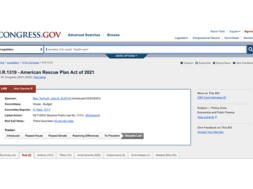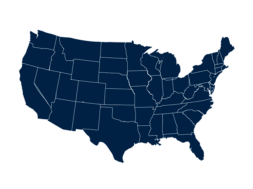
2017 Changes to the Gainful Employment Disclosure Template
By Christopher DeLuca, Attorney at Law, DeLuca Law LLC
Background
There are significant changes coming to the disclosures that schools must make regarding their gainful employment programs. On Jan. 19, 2017, the U.S. Department of Education released the 2017 Gainful Employment (GE) Disclosure Template.1 Institutions were originally instructed that they had until April 3, 2017, to update disclosures for each of their gainful employment programs using the 2017 GE Disclosure Template. This deadline was subsequently extended to July 1, 2017, to allow the Department to further review the GE regulations and their implementation.2
An institution that offers a GE program in more than one program length must publish a separate disclosure template for each length of the program. Similarly, an institution that offers a GE program in more than one location or format (e.g., full-time, part-time, accelerated) may publish a separate disclosure template for each location or format if doing so would result in clearer disclosures.
The new GE Disclosure Template makes significant changes from prior years’ templates, such as:
- Requiring distribution of the 2017 GE Disclosure Template to prospective students as a separate document before the student makes any financial commitment to the institution.
- Disclosing a single median loan debt amount for Title IV students who completed the program on-time during the award year, without separating Title IV debt from private loans and institutional financing plans.
- Disclosing the median earnings data used to calculate the final GE Debt-to-Earnings (D/E) rates.
- Publishing student warnings for programs that failed the D/E rates measure. Those warnings must be added to the disclosure template within 30 days of receiving a GE program’s final D/E rates from the Department.
- Providing information about whether the program meets licensure requirements for any states in the metropolitan statistical area (MSA) in which the institution is located.
The 2017 GE Disclosure Template is available online at:
https://www2.ed.gov/policy/highered/reg/hearulemaking/2009/negreg-summerfall.html
Also available on the above web page is a comprehensive GE Disclosure Template Quick Start Guide to assist institutions in using the new GE Disclosure Template.
Distribution of GE Disclosure Template to prospective students
Perhaps the most significant change from prior years is that the 2017 GE Disclosure Template must be distributed to prospective students as a separate document before the student signs an enrollment agreement, completes registration, or makes any financial commitment to the institution.
The disclosure template may be provided by hand-delivering it (individually or as part of a group presentation) to prospective students. Written confirmation of receipt must be obtained from the prospective student. The disclosure template may also be provided by sending it to the primary email address used by the institution for communicating with that student. If using email, the school must ensure that the disclosure template is the only substantive content in the email. If email delivery is utilized, the institution must receive electronic or other written acknowledgment that the email was received by the prospective student. If the institution receives a response that the email could not be delivered, the disclosure template must be sent using a different address or delivery method.
In all cases, the institution must maintain a record of its efforts to provide the disclosure template. Institutions must begin complying with these new disclosure distribution requirements no later than the July 1, 2017, deadline established for posting the new template. It is important for schools to work with their financial aid and admissions staff to develop processes to ensure that these distribution requirements are satisfied prior to the deadline. Schools should also expect that their auditors will be reviewing compliance with this requirement when they are conducting the schools’ annual Title IV compliance examinations.
On-time completion rates
To calculate completion rates for the GE Disclosure Template, schools must report the total number of students who enrolled and the number who completed the program on time. For GE purposes, “on time” means that the student completed the program within the normal time to completion. The Department defines “normal time to completion” as the amount of time necessary for a student to complete all requirements for a degree or certificate according to the institution’s catalog.
It may take students longer than the time published in the institution’s catalog to complete their program. For example, Department guidelines allow a school to adopt a policy that treats a student as making satisfactory academic progress so long as the student completes the program within 150 percent of the scheduled time to complete.
However, if a student takes longer than the time published in the institution’s catalog to complete the program, then the student would not be included in the completion rate published in the GE Disclosure Template.
For this reason, the completion rate published in a program’s GE Disclosure Template may be substantially different from the completion rate that the institution reports to its accrediting agency.
Student loan debt
The program’s student loan debt is based on the median cumulative amount of debt for all Title IV students who completed the program. For GE disclosure purposes, a student is counted as a completer if the student completed the program within the normal time to completion as described above. This means that not all program completers are included when calculating the median debt for GE disclosure purposes, but rather only those students who completed the program on-time according to the Department’s definition.
The amount of each program completer’s gainful employment debt includes all private, institutional and Federal student debt. Schools will enter this median debt amount into the template, along with the applicable interest rate used by the U.S Department of Education to amortize the median loan debt for the program. The template will use these two numbers to calculate the amount a typical graduate pays per month in student loans, assuming a 10 year repayment period. This monthly loan payment amount will appear on the final disclosure. Note that if the institution reports fewer than 10 completers, then the student loan debt fields are disabled in order to preserve the confidentiality of the loan recipients.
Median earnings disclosure
Institutions are required to enter the median earnings most recently provided by the Department for the program into the GE Disclosure Template. Note that this differs from the method used for calculating a program’s D/E rate. To calculate a program’s D/E rate, an institution is allowed to use the higher of the program’s mean or median income. However, for purposes of the GE Disclosure Template, the Department is requiring institutions to use the program’s median earnings amount even if it is lower than the mean income.
Institutions will indicate on the disclosure template if they have submitted an alternate earnings appeal to the Department for a program. If an alternate earnings appeal has been submitted, the institution must still disclose the program’s Social Security Administration median earnings that were provided by the Department until the appeal is resolved.
Gainful Employment performance
When completing the GE Disclosure Template, an institution will need to indicate whether the program is passing, failing, or in the zone. If the program is failing, then the GE Disclosure Template will include a warning statement that reads:
This program has not passed standards established by the U.S. Department of Education. The Department based these standards on the amounts students borrow for enrollment in this program and their reported earnings. If in the future the program does not pass the standards, students who are then enrolled may not be able to use federal student grants or loans to pay for the program, and may have to find other ways, such as private loans, to pay for the program.
If an institution has made or will be making a timely submission of an alternate earnings appeal for the program, then the institution may wait to update the program’s GE Disclosure Template to the version that includes the warning language until after the Secretary accepts or denies the appeal.
Job placement
Institutions are required to provide job placement rate information for its gainful employment programs. This information is based on data that the institution submits to its accrediting agency as well as any job placement data reported to its state licensing agency. For example, California requires that private postsecondary schools report job placement data that may be different from the methodology used by national accrediting agencies. A school in California would be required to report on its GE Disclosure Template both the job placement rate calculated for the school’s accrediting agency as well as the job placement rate calculated under the California rules.
Program licensure requirements
Institutions are now required to provide information about whether a GE program meets the licensure requirements for any states in the metropolitan statistical area (MSA) in which the institution is located.
Institutions must also provide information for any states for which the institution is aware of whether the program satisfies all educational prerequisites to qualify a student for licensure.
For example, the Washington, D.C. MSA includes Maryland, Virginia, and the District of Columbia. A school located in Washington, D.C. would need to provide information about whether its GE program meets the licensure requirements for Maryland, Virginia, and the District of Columbia.
The GE Disclosure Template includes a link to a government website that contains information to assist schools in determining their applicable MSA.
Completing the GE Disclosure Template
Once all screens on the GE Disclosure Template have been completed and reviewed, the institution can generate a ZIP file containing two versions of the disclosure in HTML format, one for the web and the other for printing. The output file contains a custom web page for hosting on the institution’s website. It is important to carefully review the provided information for spelling, grammatical errors, and content. The downloaded ZIP file constitutes the only copy of the output file with the institution’s data. This data is not retained anywhere, so it is important that this file is saved locally and its location noted before closing the GE Disclosure Template data entry form.
Availability of the 2017 GE Disclosure Template
Any web page containing academic, cost, financial aid, or admissions information about a GE program must include the GE Disclosure Template for that program or a prominent, readily accessible, clear, conspicuous, and direct link to the program’s disclosure template. In addition, all promotional materials made available to prospective students that identify a GE program by name or otherwise promote the program must include the GE Disclosure Template in a prominent manner. Where space or airtime constraints preclude inclusion of the template itself, the web address of, or the direct link to, the GE Disclosure Template must be provided. An example of a compliant disclosure under this guidance could include the following text:
For more information about our graduation rates, the median debt of students who completed the program, and other important information, please visit our website at, www.XYZcollege.edu/ABCprogram/disclosure.”
The GE Disclosure Template must also be included in all promotional materials about the GE program. Promotional materials include invitations, ads, course catalogs, social media, etc. that mention or otherwise refer to a specific GE program. If not feasible to include the template, the institution must include a live link or URL to it and clearly explain what is available at that web page.
Resources
- Gainful Employment Electronic Announcement #103 – Release of the 2017 GE Disclosure Template, January 19, 2017.
- Gainful Employment Electronic Announcement #105 – Additional Time for Submission of an Alternate Earnings Appeal and to Comply with Gainful Employment (GE) Disclosure Requirements, March 6, 2017.
CHRIS DELUCA is the founder of DeLuca Law LLC. Chris has 25 years of experience providing legal, financial and management services to business owners and career school operators. In addition to being a licensed attorney, Chris is also a certified public accountant (inactive status).
Prior to founding DeLuca Law LLC, Chris spent nearly nine years serving as in-house legal counsel and Chief Financial Officer for a multi-state cosmetology school group. Chris was responsible for the school’s compliance with laws and regulations for participation in the Title IV federal student aid programs. He also managed compliance for the schools’ accreditation with the National Accrediting Commission of Career Arts & Sciences (NACCAS).
Chris serves as Co-Chair of the American Association of Cosmetology Schools’ Government Relations Committee, and is a frequent speaker at AACS and other national and regional school conferences. His recent speech topics include the implementation of the Violence Against Women Act (VAWA), Title IX and the Clery Act, school responsibilities under the Americans With Disabilities Act, Gainful Employment reporting and disclosures, school consumer disclosure requirements, and borrower defense to repayment. He also served as the alternate negotiator representing for-profit schools at the U.S. Department of Education’s negotiated rule making sessions regarding the borrower defense to repayment regulations.
Contact Information: Christopher DeLuca // Attorney at Law // DeLuca Law LLC // 513-401-8977 // chris@delucalawllc.com // DeLucaLawLLC.com











